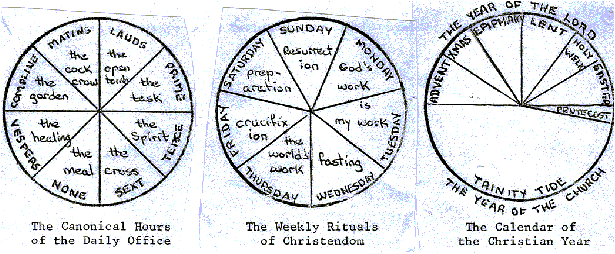
July, 1982
In the name of the Father, and of the Son and of the Holy Spirit.
Amen.
In the name of God, the creator and destroyer of all of life,
in the name of the Christ, the permission giver and redeemer of
all of life, in the name of the Holy Spirit, the God within all
of life. Amen.
In the name of the limits, the possibility and the free decision
of life. Amen.
Which is to say, life is never the way we want it, we refuse to
accept its promise, nevertheless, we are free to live. So be it.
I have been greatly blessed this year with the opportunity of
going back to school. I requested that assignment for several
reasonsone was a great concern about our symbolic
life. I was not ever so naive as to think that all of the answers
could be found in one year of study, but I was hopeful that we
would find a few of the directions that we should go.
I want to share four things with you today. One is the context
of rituals which has exploded my imagination during the last year.
The second is the function of ritual. Next, I will talk about
our own tremendously rich experiment in the ritual process. And
finally, I will outline some implications for the future.
This is from the writings of Raimundo C. Panikkar.
The most positive way to overcome a tradition is not to step out
of it (as if it were a bullock cart) or to cancel one's membership
(as if it were a club), but to live that 'tradition', i.e. to
'pass it on', to continue it, to climb to the top where other
peaks are visible and/or to descend to the depths where the throbbing
of the world is perceptible. I feel that I owe it to many to explain
the continuity of my path in spite of the mutation that has taken
place both in me and in our world.
I can only be free from a certain type of Christianity or Hinduism
(and for that matter from a certain type of Buddhism and Secularism)
if I become a better Christian and a better Hindu.
I want to spin a story of how rituals got started. There were
not always rituals. The earliest evidence of ritual that we have
found so far dates from 180,000 BC in a cave in the Alps. Those
who have read Clan of the Cave Bear will appreciate that
what was found was 20 bear skulls arranged in very careful order,
pointing to the east. Now, what was the story? How did they get
there and what do they mean? Nobody recorded it, so the story
is ours to invent. My story is that one spring day, as the people
of a very early human form were looking for the first fresh food
of the season, they came upon a huge cave bear. After much struggle
they finally killed it. But, then another cave bear appeared,
then three more appeared. Finally, there were 20 cave bears. This
little group of human beings had to face and conquer the bears
or be destroyed. It was a totally impossible situation out of
which to forge a victory. No little group of human beings can
conquer 20 cave bears! But they did. Obviously, there was some
greater power within them or behind them or acting through them
that allowed this mighty victory. They could not explain it, so
they carried the skulls into the cave and laid them in place.
They said, "There is something here that we do not understand.
Let's not forget it. There is something more to life than oneonone.
Let's remember it." So they laid the skulls on the ground
and probably had some sort of reenactment with it. The important
thing is that from that moment on there was time. There had not
been time before that, but an amazing event had happened. Then
there was a time before and a time after the encounter with the
bears. There was a memory of an event which changed history. In
due time, paintings appeared on the wall. Later words emerged
to rehearse the story until there was a total acting out of that
great adventure, that great event when the impossible happened.
What came into being was the first ritual.
Some scholars talk about that as a hierophany or kratophany or
theophanya mysterious encounter, a manifestation of
the power of the sacred or God in the midst of human life. We
have a hard time talking about that kind of encounter today. We
know it still happens. It occurs in all of our lives. There are
some events that so fill us with the awe, wonder, power and mystery
of life that from that time on we struggle to even get a picture
of what's happened. We dare not forget it. All of time becomes
focused in the power of an event and in recalling the event. We
reclaim the wonder and the terror, the fear and fascination which
is involved.
The book Ancient of Days gave a fair description of how
another understanding of time came into being. It was quite a
reasonable thing to be scared to death in that time. The days
kept getting shorter and shorter and the weather colder and colder.
They had reason to fear. A dim memory of the Ice Age remained
with them. Perhaps the trend would continue until it was only
night and only ice. But someone, the book names Ronstrom but any
name might do, conceived of the notion that there was a pattern
to the weather. He believed there were cycles of time. Stonehenge
was built to mark the time. They said, "The sun will move
south until the shadow is here, then it will move north again.
For the rest of our days we do not have to be afraid. We can rejoice
at this shortest day because it means longer days are returning.
This is life and therefore we can live before it." Not only
the people of northern Europe, but the people of the whole world
had this experience. They came to realize the cycles of time.
Every culture on the face of the earth has some sort of celebration,
some sort of feast of lights, that marks the shortest day and
says that there is something comingthis is part of
the cycle.
The Jews lived out of a cycle of festivals until they went into
exile. But when they were carried off into captivity these rituals
alone did not sustain them. The rituals did not meet the yearning
and pain and anxiety in their souls. They found themselves remembering
specific events like the Passover and the Exodus. They remembered
the Red Sea and when they came back to Palestine. They remembered
their whole calling and their covenant. They put an overlay on
the cycles. There was a spring solstice Passover,
an autumn solstice Atonement, and in time a winter
solsticeHannukah. An overlay of depth meaning allowed
time to become lineal. People saw that it was not just one cycle
after another, but that time was moving. There was change and
possibility and that is what life is about. Thus a whole new understanding
and a whole new ritual came into being.
In the 20th Century I want to suggest we have a new grasp after
the timespace continuum, or what Einstein calls processualized
space/time. Time is not the same everywhere. Around the globe
and throughout the universe the experience of time is not always
what it is for us. At the same time there is a new sense of the
wholeness of all of life. There is a sense that the past and the
future is ever present. We are ripe for new rituals. It is very
clear that none of the old rituals hold the new understanding
of life that reaches out and gives you something to live out of.
Therefore, we have a task before us of dealing with rituals.
Before I say more about our future task, let me talk about particular
rituals. I want to say very clearly that I am aware that I am
speaking as a white Christian. That is the only perspective from
which I can speak. I look forward to the day that a Buddhist,
a Hindu, a Muslim and others stand here speaking of ritual from
their perspectives. But today I can only share insights from one
perspective, that of Christianity.
In the Christian story we spent our first 300 years being underground.
We were in fear for our lives. The rituals which were developed
were designed to teach us how to die with courage, with meaning,
with significance for all of life. We baptized people into the
death of Jesus. The sacrament was an oath of allegiance unto death,
because life was soon to go out of being. The only possibility
for meaningful life was to be faithful until they died.
But then in 313 AD the Edict of Toleration declared that we were
no longer the hideaways, no longer being sought out to be killed.
Christianity was in fact the state religion of the most important
state of the western world. Well, that created quite a crisis!
We did not know what to do. What on earth do you do when all your
rituals have been saying this is the way to die and suddenly you
are being called upon not to die but to live? Well, they went
back to the earliest rituals and tried to recover the meaning
of them.
 |
It took more than 200 years to resolve the ritual crisis. The
liturgical system was formalized and put in concise form by the
time of Benedict in 527 AD The liturgy was designed to create
a model for daily life out of the paradigm of the life, death
and resurrection of Jesus the Christ. Benedict devised a fantastic
system of the daily office. The canonical hours include the eight
seasons of prayer during the day. The seven days of the week each
rehearses again expenditure, crucifixion and resurrection. Every
hour and day tells the story that allows life to count and states
what your life is about. There was a calendar of the Christian
year which rehearses the mystery of life once more.
There is the year of the Lord and the year of the Church; there
is a time for remembering the expectations, a time for remembering
the gifts, the kingships, and the fallenness and the brokenness
and the resurrection. It rehearses the whole of life again very
concretely in order to say that our lives as human beings are
all about longing for something that isn't here. That longing
is human and good. To accept that longing, repent of it, and live
in it every day is the message. Our life is full of being gifted,
being unworthy and being magnificent. The rituals say rejoice,
you do not have to earn this gift. It is yours. Every bit of the
structure of the day, the week and the year dealt with the existential
life of human beings, with sanctifying it, bringing life, healing
and significance into all aspects of life.
In our modern day, we have a hold of a new reality. Canonical
hours no longer are as relevant for the church. It took them 216
years to come up with that ritual answer to their dilemma. We
too have time to continue work on the ritual process for our day.
We are in a similar period of betweentimes, when the old
ways are no longer adequate and the new ways have not yet taken
root. We have talked about it as being between modern and postmodern
times. Here is a familiar chart of the premodern, modern
and postmodern times. It has a few different words from
what we usually use. I found it refreshing to go back to school
and find out that other people are talking exactly the way we
have been. They use different words and sometimes have a fresh
way of grasping what it is all about.
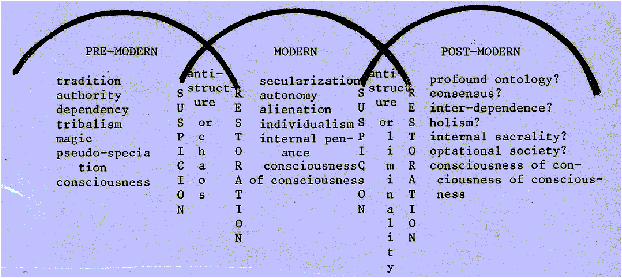 |
In the premodern time, we lived with a very clear understanding
of our relationships. We lived the structure of society. Our loyalties
and our feelings were limited to our tribe or nation or race.
Pseudospeciation is a formal word for naming the attempt
to make narrow loyalties a natural order of things. Our religion
and our piety were akin to magicthough it can be argued
that this was an accretion to the deep grasp of reality to which
our ritual life has always pointed. Whenever the zenith of creativity
is passed, accretions begin to build up like barnacles to disguise
and weight the freedom of the spirit.
In the modern world, our times have been marked by autonomy, by
reaction to societal structuring and to anything which is not
scientific and empirical. We have experienced the collapse of
all structures with the result that we fight with our lives to
discover what a family is, what a community is, and what it means
to be human. Alienation, suspicion and immediacy mark our time.
But we are weary of the chaos and long for peace and a commonsense
approach, a new structuring that will bring full life for all
earth's inhabitants. People on the street are aware of the powers
and mystery in the midst of life, but as a society and a world,
we have not found the way to ritualize or to dramatize that the
power, that enabled the killing of 20 cave bears, is within us
and with usa power which is not our own and yet which
we possess. We are camping out in the last days of the modern
era with a vision of what could be but no clear way to move toward
it
The categories under the postmodern world section are suggestions
made by Victor Turner and others as they see the world and the
emerging paradigm. The wholeness and profundity of life which
are in the midst of this life are emerging again. We have to grasp
the mystery, power and wonder that is life and live it all over
again. But in the meantime, we live in a time of liminality. We
live in a time of antistructure. We live in a time that is no
longer modern and it is not yet postmodern.
Liminality is a term used a great deal in writing and speaking
today. It comes from the word "limen", which means threshold.
It means standing in the doorwaywhen we are not outside
and we are not inside, we're really nowhere. We stand in the chaos
and in ambiguity. We, as a society, struggle particularly with
the breakdown and collapse of all the things on which we thought
we could depend. We constantly face the leveling of human groups
and the neglect of tradition. We face unknown anonymity, reversal
of status and ambiguity that is upon the face of the whole earth.
We, in this particular body, The Order: Ecumenical have built
that structure into our yearly, daily and weekly time designs.
Perhaps, our greatest gift is what we know about liminality.
Society is very clear about how to perform the ritual of suspicion,
or as Ricouer calls it, the hermeneutics of suspicion. People
know how to cut themselves off from the past. They burn flags,
tear up draft cards, revolt against another nation that has held
them in league and stage protests. There are many ways to say
no to the links to the past. Society has learned that well, but
society has no way to deal with the rituals of restoration. We
know we will never go back to the old traditional autocratic,
hardnosed ways. The question now is how do we perform the
rituals of closurethe rituals of restorationthat
allow us to structure the unity, wholeness and stability that
can nurture all our lives? How do we say no to the partial and
yes to the wholeness of life? I believe this is the arena where
we have something to offer.
As long as society does not have the rituals of restoration, we
can only continue in the chaos, pain and suffering which are seen
in every home and on every city street. Victor Turner says that
religions no longer have the power to create the healing society
needs. Now religion has not lost power, it is the religious institutions
which have lost power. Other components of society are picking
up the religious dimension. For instance, artists, great novel
writers and poets are doing a tremendous job of getting the religious
perspective into life.
Another one of these components is the legal sphere. Sally Moore
suggests that the most acceptable rituals of healing in our society
today are the legal ones. These pronounce guilt and innocence,
existence and termination of relationships, penalties and rewards
decreed by society at large. Society as a whole tends to support
and acknowledge legal rituals when it flaunts all others. Yet
legal rituals, by their very nature, cannot deal with the depth
human issues of people and society and cannot bring healing and
transformation into the spirit depths of life.
Thus, there is a strange anomaly, for at the same time that we look for rituals of closure we are desperately in need and of rituals of restoration. Victor Turner says that the base of all these rituals is the root paradigm. He says that the society appears to be operating smoothly at the surface level, like a fine veneer of soothing interaction until some break or dysfunction appears in the social structure. If this deepens into crisis, then suddenly the panic syndrome causes us to act with a passion we were not aware we possessed. This diagram looks a little bit like the Ur image diagram we've used. When rupture occurs we act, not out of our self images, not out of our
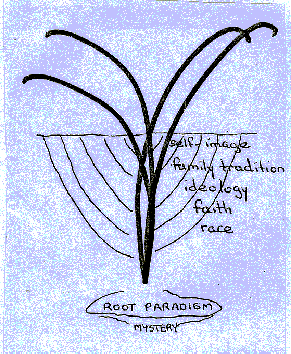 | family traditions, ideologies' religious faiths, race. We find exploding within ourselves, erupting out of ourselves something that we cannot explain. This happens not so much in the time of crisis as when we try to heal the crisis, bring redress. Then we find ourselves other people acting out of strange, deep, perplexing motives that are far below the levels of our consciousness. Turner calls this level the root paradigm. Now a root paradigm may be totally destructive or it may be totally helpful and creative. We have seen both in our day. I find I have great anxiety when we use the line in a ritual, "life only comes from a death." Of course, life only comes from death; everybody knows life only comes from death. The Jews understood that dynamic. That's why they killed pigeons for sacrifice. They rehearsed that dynamic on the Day of Atonement. That's why |
today people killed an old man on the street a few blocks from
the Chicago Nexus. They believed that life only comes when you
get the opponent out of the way and you grab what is his. Behind
these deaths, you find the root paradigm that says life only comes
through the death of the enemy, or life only comes through human
sacrifice.
We come from another tradition that says life only comes when
life is given up on behalf of another. That is a totally different
paradigm. Do you remember the Spanishspeaking black man
in the book The Pawnbroker? He worked for the pawnbroker. Near
the end of the book when the shots were fired by the thief, he
flung his body in front of the pawnbroker. As he lay dying the
pawnbroker asked him, "Why did you do that? Did you think
about what you were doing? Was it intentional? Was it just reaction?
How did you happen to give your life for me?"
This decision is not a cerebral process, it is something from
the very depths of our being that forces us to act in one way
or another. Of course, we are clear that we have the paradigm
we choose to stand before, and we have a great many images already
within our own minds. Yet at moments of great decision, a deep
passion already within us bursts up, explodes and erupts. How
do we judge and decide? Why do we act this way and not that way?
Is it because of some sort of stoic decision? I don't think so.
Is it an intellectual decision? I don't think so. It happens through
something which we have trained ourselves to understand with our
bodies, with our minds and with our senses. For we realize that
ritual finally has almost nothing to do with intellect. Ritual
comes out of a depth life experience in which we stand before
the awe and the mystery of life. We use some way of deciding which
involves all our senses. It involves touch, the smell of spring,
the sign of blue, the sight of a candle and the feel of the cold.
These kinds of things become icons first. They recall the span
of our experiences. Then, in reflecting, we slowly discover words
that help us articulate those experiences. These words form in
our memory, in our visioning, in intuitions, in hoping, and in
dreaming. These ways of articulating, these ways of recalling
our experiences, we call myth.
We take all of thisthe pictures, the sound, the feeling,
the articulationand we put them together in an acting
out, a drama which rehearses life all over again, for it recreates
the event. It recreates the possibility of the wonder and the
power. The drama allows us to bring the "happening"
into this very moment. This is the ritual, the enactment that
involves all of our powers, all of our senses and all of time
and space. This body of people have done a superb job in this
arena, but we must not forget the scope of the ritual process
lest we become traitors to life itself. We must not cling to what
we have done in the past, but we must cling to the wisdom of the
past. We dare not slip into any notion that just reciting a few
words is doing the ritual.
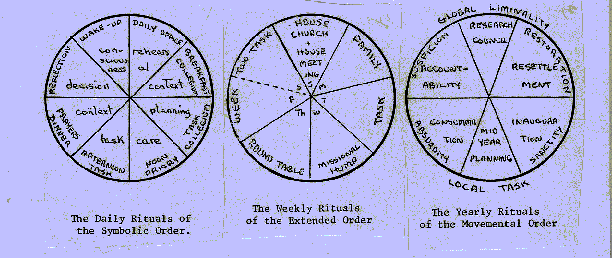 |
The ritual in which we are involved is more than the ritual of
Daily Office done at 5:30 in the morning or the rituals we may
do around collegium tables. They are part of the ritual process,
but the ritual process is much bigger. The ritual process includes
everything we do, everywhere we go and every action in which we
participate. It is our whole life together. This is tremendously
important! If we look at this next image we will see that we have
put an overlay on the Christian symbols of the canonical hours.
Seven times a day we publicly rehearse accountability and absolution.
This is a major, dominant theme of our ritual system. Accountability,
absolution and assignment may be one of the most important things
that we do. That dynamic is desperately needed by the world today.
People are not held accountable, except by accusation. They are
not absolved, except by being told that their expenditure is insignificant
and doesn't matter. Assignment comes as drudgery and burden. But,
for us, accountability is the significating of every human being's
expenditure. Absolution is acknowledging that it is out of the
very failure of our corporate and individual lives as well as
the success that the future is birthed. We must remain conscious
of that gift of life. Our task every-time we gather together,
every time we send each other out is to acknowledge that we are
those people who have a task to do and the task must go on. That
is our gift.
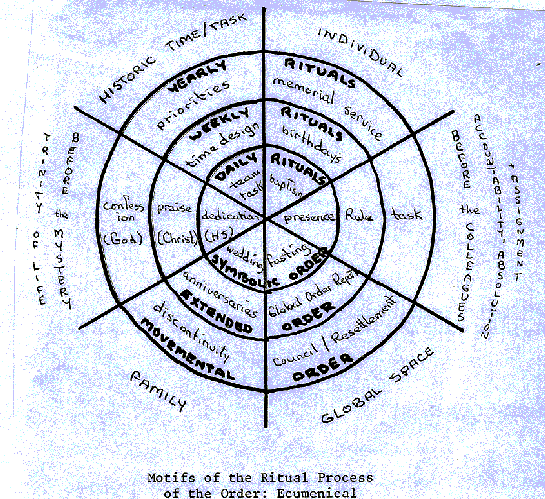 |
Within all of our time as an Order, there is an overlay of the
themes and motifs that run through our rites. For instance, in
the historic time/task section of the image above there is a team
task every day, a time design for every week, and priorities that
are named yearly. Each step has a highly defined ritual that overlays
our time.
We also bring all space into our engagement at every moment. Each
day at breakfast, the ritual of reading the names of the houses
which are fasting brings the globe into the collegium room. This
may be the first time in history that time and space have been
united in rituals in this way. Every week as we read the Global
Order Report, all of space is with us selfconsciously. Every
year as the priors gather in this room and as the assignments
are made, people bump up against the global dynamic. Finally,
there is no way that we can live before only one local situation,
yet the local is present, too.
We celebrate the individual and the family. Weddings and baptisms
take place in the context of Daily Office. Birthdays and anniversaries
are celebrated every week. Memorial services and discontinuity
to visit extended family are held within our patterned time. All
of this allows every dimension of our lives to be part of our
rituals and existence and to be a healing dynamic in life. Therefore,
these things are tremendously important but not just for ourselves.
If all of this were just for the sake of having a great community,
then we should forget it. But if you remember the way society
erupts and has no chance to ritually become a community again,
then understand that what we have here is a way to serve society.
We have a way to bring that closure, that healing to society again.
We already do that. Town Meeting brings ritual healing. The Global
Social Demonstrations are doing exactly that. LENS does that.
All our social programs are, in fact, ritual processes for the
healing for all of society.
We have to be clear about the rituals we regularly enact because
we are now in the position where we have to create new rituals.
We have to create new ways of acting out and dramatizing our rituals.
We have to hold onto the fact that ritual in its simplest form
is about only three things.
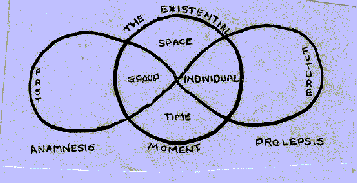 |
The first one is anamnesis. Anamnesis simply means against amnesia,
against forgetting. It has to do with the intentional recollecting
of those things and those events which life has taught us are
crucial. In every ritual we have to selfconsciously ask
what is it that we have to remember. Why is it that we dare not
forget? What are the mysterious intrusions of power and wonder
into our lives that are necessary for our livesthose
without which we would be destroyed or taken out of existence?
We traditionally celebrate this on Sunday when we break bread
and spill wine. We rehearse or remember that this is the way life
isbroken and yet whole, spilled out and yet full.
All of life is this way. That is what we are saying we have to
remember.
The second thing that ritual is about is called the prolepsisthat
which allows us to make the leap into the future. For any ritual
which only holds onto the past, which only remembers the past
is unhealthily attached to the obsolete. What good does it do
to remember the Holocaust except for the sake of seeing that it
never happens again? What good does it do to remember the mistreatment
and the pain that minorities and women have suffered unless it
is linked with a will to transcend the past, to break through
into a new relatedness which uses those agonies to produce sensitive
concern for all human life and all cultural manifestations. What
good does it do to remember all of the gifts we have received
in the past as a nation if it is not for the sake of the future
and for visioning what it could mean for all people to live free
and to live with the goods that they need in this world as human
beings.
Anamnesis and prolepsis are the two bookends of ritual and they
are easy, in one sense, to deal with intellectually. The crucial
aspect is the middle part which is the existential momentthe
existential engagement. Our feelings and intuitions, our particular
experiences of the heat and the cold, the task before us, and
the pain and the struggle of that task are all dimensions of that
moment. It is the existential moment that defines what we are
doing. This is why it was fantastic in the old form of the Daily
Office when a colleague spontaneously got up and danced down the
middle of the Great Hall. In the formality of our daily ritual,
we must not lose the spontaneity, the possibility of calling out
what must be in the future. We must continue to rehearse in depth
our history. We must continue to involve our whole body, for ritual
is not a cerebral matter, it is corporeal. It is not a matter
of speculation, it is a matter of praxologythe practice
of living out our lives. It is not a matter of stepping aside
from life and being detached from it. It is a matter of really
engaging in all of life for 10 to 20 minutes a day in order that
the rest of our time may be lived out of the wholeness and healing
that is there.
A symbol of the existing rituals of the Order: Ecumenical suggests
that of the many symbols, myths and ritual acts which have developed
in projects and houses around the world, one dominant set of ritual
components can be discerned. I want to suggest that the existential
moment for us has to do with the accountability, absolution, and
assignments that we rehearse over and over again. I see as the
icon we stand before being the earth-rise. This tremendous visual
symbol allows us to see there is one world and that it is only
a part of the entire universe. It reminds us that it is our world.
There is not any power beyond which is going to deal with it,
but
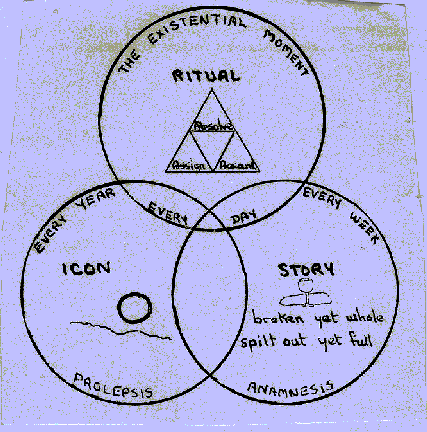 |
that mysterious power is within, about, and ever-present creating
wholeness and fullness. The story that we need to rehearse and
not forget is that the brokenness of life and the wholeness of
life is that by which we are all allowed to live life fully.
The thing that is so exciting to me as I study the ritual process
is the discovery that it is our ritual life which society needs.
It is our ritual life as revealed in our secular courses and daily
activities, although we have just barely scratched the surface
of the process. We need to be working at two levels. One is our
external ritual mission, and the other is our internal ritual
enactment. The two together bring healing. We cannot forget either
one. Unless we are very intentional and very careful of what we
get said in our internal life, our external mission will go down
the drain. When we get rituals into secular language, we forget
so easily what is at the root We forget the root paradigm that
is the basis of all our ritual.
Therefore, we have a tremendous task, not to invent something
new, but to discern where the spirit of God is moving across the
face of this earth today. We need to put form on the emerging
stories, icons, bodily actions, dreams of the earth's peoples,
the whole ritual process that we see is needed for the globe.
There are some things which we do that will never become global.
They are far too limited in their applicability to the way life
always is. We need to understand again relative to our ritual
process what we have always said about our courses. It is the
structure that freights the meaning. Thus, we do not have to be
too excited if the person giving the absolution uses terrible
poetry and horrible theology, in the first instance. Because it
is the absolution, it bears all the weight of what absolution
is and therefore is effective. On the other hand, we better be
extremely careful what we say for absolution and how we articulate
our memory of the past. We must be very careful in everything
we do how we articulate the way life really is.
We have to be sure we do not point the finger at some other place
to talk about where life really is. We say "This is life!",
not "That is life!" It is here; it is not over there.
We must carefully articulate what it is and what it is not. We
have to be concerned about these aspects and yet at the same time
we have to be totally relaxed. I figure we have been working at
this seriously for ten years now. We may be able to work a little
faster than Benedict, so let's say we are going to try for 200
years to work on the ritual system. Let's be relaxed and yet be
careful about our work. Time and concern will allow us to articulate
the new ritual system.
The most amazing, frightening, terrifying and wonderfilling thing
about the symbolic arena is that presumptuous statement that we
do not do the Daily Office, we are the Daily Office
and the reality which is behind it. Any ritual begins with an
event from which pictures and images emerge which are eventually
articulated and finally acted out. What is the event which marks
the new global age? Was it the earthrise? Maybe, but I do not
think so. Was it the atom bomb? What is the global event? This
sounds so presumptuous that I am scared to say it, but I think
we are it.
We are a bunch of nobodies, an insignificant group. But when we
work togetherblack, white, red, tan, brown, and yellowin
the villages and cities around the world; when weHindus,
Buddhists, Muslims, and Christianswork together in
a Religious House for the sake of the world, we become the spirit
that is moving in us to create a new possibility. We are it. That
is a frightening thing to say. We do not believe that we could
be it. Do we realize what it means to say that we believe in the
spirit that moves and changes life, that we believe in the spirit
that is in every human life, and we believe in the power that
creates the entire universe and yet moves in individual human
lives? We believe in the God in you and me and in every human
life that continually creates new life. How do we get it said
that the creative power, the process of the universe, is not outside
the reality of life but is found as we stand before the limits
in life with a stance of possibility.
My seminary professors were baffled with us. They said, "You
people are so realistic and yet you are so optimistic. It doesn't
make sense." Then we said, "Well, that is the dynamic
of God the Father, God the Son and God the Holy Spirit."
Our task is to continue to stand in the limits with a stance of
possibilityto be our free decision.
Nan Grow